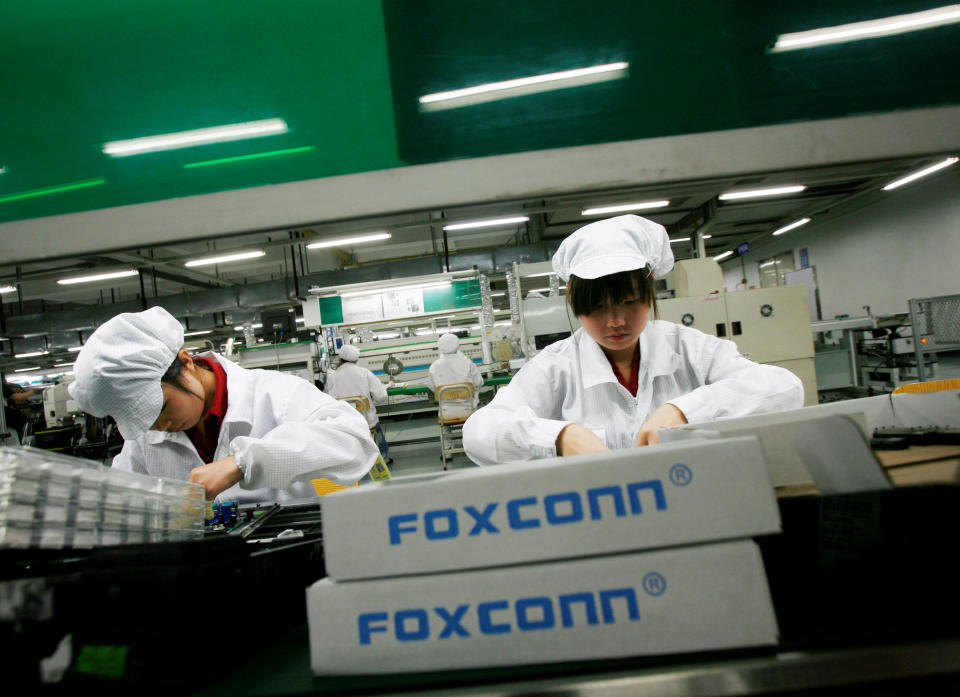Trump’s big Foxconn announcement will bring jobs — and robots
President Donald Trump finally has something legitimate to crow about—a new factory to be built in Wisconsin by Taiwanese firm Hon Hai Precision, better known as Foxconn.
The electronics giant, which assembles iPhones and builds components for many other devices, will break ground soon on a $10 billion plant to build flat-screen displays, which could create 3,000 decent-paying manufacturing jobs during the next four years, the White House says. That appears to be a down payment on a bigger investment in the United States Foxconn chairman Terry Gou promised after Trump’s surprise election last November.
Trump isn’t shy about claiming credit.
“This is a great day for everyone who believes in the label, ‘Made in the USA,’” Trump crowed during a televised appearance on July 26. “If I didn’t get elected, [Gou] definitely would not be spending $10 billion.”
What Trump and Foxconn aren’t saying, however, is that the electronics manufacturer is a premiere deployer of robots that do jobs once done by humans. Since high labor costs are often the main reason firms flee the United States or decline to locate here in the first place, the ability to automate a large part of its Wisconsin operation may enable Foxconn to manufacture in the United States while keeping costs competitive with suppliers elsewhere.
In 2015, Foxconn rolled out a plan to automate 30% of its factories by 2020. It builds 10,000 robots per year—called Foxbots—and has fielded about 40,000 of them so far. At one Chinese factory alone, Foxconn has reportedly replaced 60,000 workers with robots.
Foxconn’s push for robots isn’t just about saving money. Critics have blasted the company for years for inhumane conditions that have led some workers to commit suicide. Foxconn had said that Phase 1 of its automation plan involves robots doing work that is dangerous or unappealing to humans.

Phase 2 will focus on streamlining assembly-line efficiency and even getting rid of some redundant robots. Phase 3 will involve the total automation of some factories. “In the third phase, entire factories will be automated with only a minimal number of workers assigned for production, logistics, testing, and inspection processes,” a senior Foxconn official wrote recently in Digitimes, a Chinese electronics journal. Some Chinese factories are already nearly automated, the official said.
That’s not the way Trump characterized the Wisconsin operation.
“They’ll be investing many, many billions of dollars and creating thousands of jobs,” Trump said. He ballparked the final tally of new jobs 13,000 new jobs. In January, Gou suggested Foxconn’s investment could create 30,000 to 50,000 new US jobs. Robots may be the reason for the lower number now.
So the reality of the Foxconn factory may turn out to be less robust than the promise—but that’s not necessarily a bad thing. Manufacturers everywhere are automating factory floors, including US automakers and many other American firms. This obviously portends a rocky future for lower-skilled manufacturing workers and even some higher-skilled ones. But this sort of innovation also allows manufacturers to stay nimble and competitive—while spending a lot of money on sophisticated robots.
The technology futurists Andrew McAfee and Erik Brynjolfsson of MIT recently told Yahoo Finance that the technological change of the last 20 years is nothing compared with the imminent revolution to be wrought by artificial intelligence and machine learning. “We are never again going to have a large, prosperous, stable middle class in this country doing routine industrial-era work,” McAfee said. “The assembly line jobs of the 1970s, those jobs are gone. To try to go back to the 1950s, I find that un-American.”
Foxconn, undoubtedly, is bringing the technology of the future to Wisconsin, not the technology of the past. Trump has had little to say up till now about the role of technology and automation on the economy and the labor force. He may get an education in Wisconsin.
Confidential tip line: rickjnewman@yahoo.com. Encrypted communication available.
Read more:
Repealing Obamacare is foolish. Here are 5 better ideas
Democrats roll out another feeble economic plan
Obamacare is hurting these people–and Congress is doing nothing about it
Meet the Trump regretters, who wish they could change their vote
Rick Newman is the author of four books, including Rebounders: How Winners Pivot from Setback to Success. Follow him on Twitter: @rickjnewman

